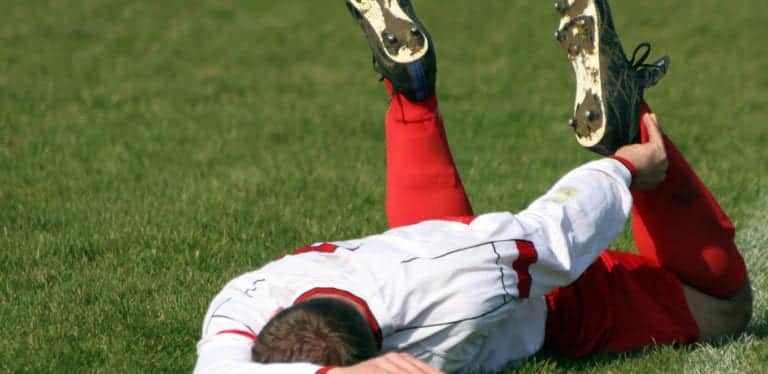
Ankle injuries are the second most prevalent injury in soccer, only behind head/facial injuries. With so much emphasis on the foot and ankle in soccer, it’s no wonder the ankle takes a beating.
Most ankle sprains in soccer occur during running, cutting or tackling. A high percentage of ankle injuries occur from direct side to side contact, as opposed to a front or back contact. Regardless of the mechanism of injury, the result is usually the ankle turning excessively inward, stretching the ankle ligaments. How much the ligaments stretch or tear will determine the extent of the ankle injury.
Types of Soccer Ankle Sprains
Grade 1 Ankle Sprain
Involves the ligament(s) being stretched and is usually accompanied by some swelling and a little soreness. This is the mildest type of ankle injury.
Grade 2 Ankle Sprain
Involves the ligament(s) partially tearing. With a grade 2 ankle injury you will typically have swelling and discoloration and you may also experience weight bearing pain.
Grade 3 Ankle Sprain
The most severe type of sprain and involves a complete tear of the ligament(s). Swelling, discoloration, weight bearing pain, and some noticeable ankle instability are associated with this type of injury.
Regardless of the extent of the ankle injury, it is always recommended to seek out medical attention from an athletic trainer, physical therapist or physician.
Ankle Injury Recovery
Please consult your physician or athletic trainer before attempting any rehabilitation exercises. Your injury may be too severe to undertake these exercises and it is always best to err on the side of caution.
RICE is the common method used by athletic trainers, coaches, and parents everywhere to quickly treat mild injuries. Follow the RICE protocol below to treat mild injuries if you’ve decided to not immediately see a medical professional.
Rest – Decrease your activity so your ankle has time to start healing.
Ice – You can apply ice to your injured ankle in the following ways:
- Ice in a plastic bag (Apply to the ankle for 20-25 minutes)
- Ice made in a paper cup (Apply to the ankle for 8-10 minutes and rip off the top of the paper cup as the ice melts)
- Immersion in ice water (5-10 minutes)
You should ice your ankle many times a day with at least 30 minutes between each ice application.
Compression – Compression helps to reduce swelling, so tightly wrap an elastic bandage around the ankle and loosen the wrap if it becomes uncomfortable.
Elevation – Elevate the ankle above the level of your heart to reduce blood flow to the area and help alleviate increased swelling.
Returning to Competition
Ankle ligaments are non-elastic which means once they have been stretched as the result of an injury the ankle will become more unstable and susceptible to yet another injury. Before returning to competition it’s a good idea to seek out an ankle brace that can help prevent another ankle injury. Before you start your soccer ankle brace search, it’s extremely important to understand the different ankle brace designs and how they may affect ankle strength, range of motion and performance.
Some soccer players wear the lace-up style ankle supports primarily because they are low profile and upon initial impression they appear to provide good ankle support. Lace-ups became popular as a replacement for the ankle tape job, which loses 70% of its effectiveness during the first 20 minutes of activity. A lace-up is basically a corset that restricts all ankle range of motion which is not ideal when you are trying to keep the ankle strong and maximize performance. Also, by restricting normal up and down ankle motion, the ankle works against the lace-up causing it to lose support rapidly
Rigid plastic ankle braces are another style of ankle brace. These types of ankle braces have a hinge and allow free up and down ankle motion to maximize performance and keep the muscles strong. They will provide much more ankle protection than the lace-up support because the brace moves with the ankle, not against it so the straps stay securely in place maintaining long last support. The downside is because these braces are rigid they can be uncomfortable and bulky which soccer players typically do not like.
A third style of ankle brace that offers the performance aspect of the hinged brace with the softness and low profile of the lace-up is the Ultra Zoom. The brace shell is made of an advanced flexible material called Performathane that uses body heat to custom-fit to the ankle. The hinged-cuff design allows full ankle range of motion and the cuff helps to restrict excessive ankle turning and twisting which causes both low and high ankle sprains.
Regardless of which type of ankle injury prevention methods you use as a soccer player, safely competing at a high level should always be one of your top priorities. If you’re a player with a history of soccer ankle injuries and want to speak with one of our certified athletic trainers about your specific situation, give us a call or send us a message and we’d be happy to help.
SHARE WITH FRIENDS
RECENT POSTS
POST BY TOPIC
- Acute Ankle Injuries (7)
- Ankle Bracing (33)
- Ankle Injuries (17)
- Ankle Injury Prevention (19)
- Ankle Instability (4)
- Athletic Trainers (2)
- Athletic Training (3)
- Basketball (6)
- Football (9)
- Hiking (2)
- injury (2)
- Mild/Moderate Ankle Injury (2)
- News (2)
- Osteoarthritis (5)
- Pickleball (3)
- Soccer (4)
- Sports (17)
- Tennis (3)
- Ultra 360 Lace-Up (2)
- Ultra CTS (6)
- Ultra Zoom (9)
- Uncategorized (2)
- Volleyball (8)